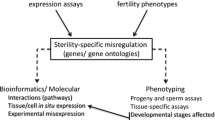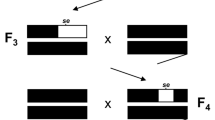Abstract
Hybrids between closely related species are often sterile or inviable as a consequence of failed interactions between alleles from the different species. Most genetic studies have focused on localizing the alleles associated with these failed interactions, but the mechanistic/biochemical nature of the failed interactions is poorly understood. This review discusses recent studies that may contribute to our understanding of these failed interactions. We focus on the possible contribution of failures in gene expression as an important contributor to hybrid dysfunctions. Although regulatory pathways that share elements in highly divergent taxa may contribute to hybrid dysfunction, various studies suggest that misexpression may be disproportionately great in regulatory pathways containing rapidly evolving, particularly male-biased, genes. We describe three systems that have been analyzed recently with respect to global patterns of gene expression in hybrids versus pure species, each in Drosophila. These studies reveal that quantitative misexpression of genes is associated with hybrid dysfunction. Misexpression of genes has been documented in sterile hybrids relative to pure species, and variation in upstream factors may sometimes cause the over- or under-expression of genes resulting in hybrid sterility or inviability. Studying patterns of evolution between species in regulatory pathways, such as spermatogenesis, should help in identifying which genes are more likely to be contributors to hybrid dysfunction. Ultimately, we hope more functional genetic studies will complement our understanding of the genetic disruptions leading to hybrid dysfunctions and their role in the origin of species.
Similar content being viewed by others
References
Adam D, Dimitrijevic N, Schartl M (1993) Tumor suppression in Xiphophorus by an accidentally acquired promoter. Science 259:359–376
Adam D, Maueler W, Schartl M (1991) Transcriptional activation of the melanoma inducing Xmrk oncongen in Xiphophorus. Oncogene 6:73–80
Barbash DA, Awadalla P, Tarone AM (2004) Functional divergence caused by ancient positive selection of a Drosophila hybrid incompatibility locus. PLoS Biology 2:1–10
Barbash DA, Roote J, Ashburner M (2000) The Drosophila melanogaster hybrid male rescue gene causes inviability in male and female species hybrids. Genetics 154:1747–1771
Barbash DA, Siino DF, Tarone AM, Roote J (2003) A rapidly evolving myb-related protein causes species isolation in Drosophila. Proc Natl AcaD Sci USA 100:5302–5307
Boake CRB, Arnold SJ, Breden F, Meffert LM, Ritchie MG, Taylor BJ, Wolf JB, Moore AJ (2002) Genetic tools for studying adaptation and the evolution of behavior. Am Nat 160:S143–S159
Boue S, Letunic I, Bork P (2003) Alternative splicing and evolution. Bioessays 25:1031–1034
Brett D, Pospisil H (2002) Alternative splicing and genome complexity. Nat Genet 30:29–30
Causton HC, Quackenbush J, Brazma A (2003) Microarray gene expression data analysis: a beginner’s guide. Blackwell Publishing, Oxford
Cork JM, Purugganan M (2004) The evolution of molecular genetic pathways and networks. Bioessays 26:479–484
Coyne J, Charlesworth B (1986) Location of an x-linked factor causing sterility in male hybrids of Drosophila simulans and D. mauritiana. Heredity 57:243–246
Crawford DL (2001) Functional genomics does not have to be limited to a few select organisms. Genome Biol. 2: interactions1001. 1001–1001. 1002
Cuadrado M, Sacristan M, Antequera F (2001) Species-specific organization of cpg island promoters at mammalian homologous genes. EMBO Rep 2:586–592
Darwin C (1859) The origin of species Random House, Inc., New York
Davis AW, Noonburg EG, Wu C-I (1994) Evidence for complex genic interactions between conspecific chromosomes underlying hybrid female sterility in the Drosophila simulans clade. Genetics 137:191–199
Dickinson WJ, Carson HL (1979) Regulation of the tissue specificity of an enzyme by a cis-acting genetic element: Evidence from interspecific Drosophila hybrids. Proc Natl Acad Sci U S A 76:4559–4562
Dobzhansky T (1934) Studies of hybrid sterility. I. Spermatogenesis in pure and hybrid Drosophila pseudoobscura. Z Zellforch Microsk Anat 21:169–221
Force A, Lynch M, Pickett FB, Amores A, Yan Y-L, Postlethwait J (1999) Preservation of duplicate genes by complementary, degenerative mutations. Genetics 151:1531– 1545
Fuller MT (1998) Genetic control of cell proliferation and differentiation in Drosophila spermatogenesis. Semin Cell Dev Biol 9:433–444
Gibson G (2002) Microarrays in ecology and evolution: A preview. Mol Ecol 11:17–24
Hinman VF, Nguyen AT, Cameron RA, Davidson EH (2003) Developmental gene regulatory network architecture across 500 million years of echinoderm evolution. PNAS 100:13356–13361
Hutter P, Roote J, Ashburner M (1990) A genetic basis for the inviability of hybrids between sibling species of Drosophila. Genetics 124:909–920
Ihmels J, Bergmann S, Barkai N (2004) Defining transcription modules using large-scale gene expression data. Bioinformatics: bth166
Johnson NA, Perez DE, Cabot EL, Hollocher H, Wu C-I (1992) A test of reciprocal x-y interactions as a cause of hybrid sterility in Drosophila. Nature 358:751–753
Johnson NA, Porter AH (2000) Rapid speciation via parallel, directional selection on regulatory genetic pathways. J Theor Biol 205:527–542
Johnson NA, Porter AH (2001) Toward a new synthesis: population genetics and evolutionary developmental biology. Genetica 112--113:45–58
Khaitovich P, Weiss G, Lachmann M, Hellmann I, Enard W, Muetzel B, Wirkner U, Ansorge W, Paabo S (2004) A neutral model of transcriptome evolution. PLoS Biology 2:e132
Liang P (2002) A decade of differential display. BioTechniques 33:338–346
Liang P, Averboukh L, Pardee AB (1993) Distribution and cloning of eukaryotic mRNAs by means of differential display: Refinements and optimization. Nucleic Acids Res 21:3269–3275
Lynch M, Force A (2000) The probability of duplicate gene preservation by subfunctionalization. Genetics 154:459–473
Meiklejohn CD, Parsch J, Ranz JM, Hartl DL (2003) Rapid evolution of male-biased gene expression in Drosophila. PNAS 100:9894–9899
Michalak P, Noor MAF (2003) Genome-wide patterns of expression in Drosophila pure species and hybrid males. Mol Biol Evol 20:1070–1076
Michalak P, Noor MAF (2004) Association of misexpression with sterility in hybrids of Drosophila simulans and D. mauritiana. J Mol Evol 59:277–282
Modrek B, Lee C (2002) A genomic view of alternative splicing. Nat Genet 30:13–19
Muller HJ (1940) Bearings of the Drosophila work on systematics. In: Huxley J (ed) New systematics. Clarendon Press, Oxford, pp. 185–268
Muller HJ (1942) Isolating mechanisms, evolution and temperature. Biol Symp 6:71–125
Nadon R, Shoemaker J (2002) Statistical issues with microarrays: Processing and analysis. Trends Genet 18:265–271
Nielsen MG, Wilson KA, Raff EC, Raff RA (2000) Novel gene␣expression patterns in hybrid embryos between species with different modes of development. Evol Dev 2:133– 144
Noor MAF (2003) Evolutionary biology: genes to make new species. Nature 423:699–700
Noor MAF, Grams KL, Bertucci LA, Almendarez Y, Reiland J, Smith KR (2001) The genetics of reproductive isolation and the potential for gene exchange between Drosophila pseudoobscura and D. persimilis via backcross hybrid males. Evolution 55:512–521
Noor MAF, Michalak P, Donze D (2003) Characterization of a male-predominant antisense transcript underexpressed in hybrids of Drosophila pseudoobscura and D. persimilis. Genetics 165:1823–1830
Nurtdinov RN, Artamonova II, Mironov AA, Gelfand MS, (2003) Low conservation of alternative splicing patterns in the human and mouse genomes. Hum Mol Genet 12:1313–1320
Nuzhdin SV, Wayne ML, Harmon KL, Mcintyre LM, (2004) Common pattern of evolution of gene expression level and protein sequence in Drosophila. Mol Biol Evol 21:1308–1317
Orr HA, Irving S (2001) Complex epistasis and the genetic basis of hybrid sterility in the Drosophila pseudoobscura bogota-USA hybridization. Genetics 158:1089–1100
Pantazidis AC, Galanopoulos VK, Zouros E (1993) An autosomal factor from Drosophila arizonae restores spermatogenesis in Drosophila mojavensis males carrying the D. Arizonae y chromosome. Genetics 134:309–318
Parisi M, Nuttall R, Naiman D, Bouffard G, Malley J, Andrews J, Eastman S, Oliver B (2003) Paucity of genes on the Drosophila x chromosome showing male-biased expression. Science 299:697–700
Perez DE, Wu C-I, (1995) Further characterization of the Odysseus locus of hybrid sterility in Drosophila: One gene is not enough. Genetics 140:201–206
Perez DE, Wu C-I, Johnson NA, Wu M-L, (1993) Genetics of reproductive isolation in the Drosophila simulans clade: DNA marker-assisted mapping and characterization of a hybrid-male sterility gene, Odysseus (Ods). Genetics 134:261–275
Porter AH, Johnson NA (2002) Speciation despite gene flow when developmental pathways evolve. Evolution 56:2103–2111
Presgraves DC, Balagopalan L, Abmayr SM, Orr HA (2003) Adaptive evolution drives divergence of a hybrid inviability gene between two species of Drosophila. Nature 423:715–719
Ranz JM, Castillo-Davis CI, Meiklejohn CD, Hartl DL (2003) Sex-dependent gene expression and evolution of the Drosophila transcriptome. Science 300:1742–1745
Ranz JM, Namgyal K, Gibson G, Hartl DL (2004) Anomalies in the expression profile of interspecific hybrids of Drosophila melanogaster and Drosophila simulans. Genome Res 14:373–379
Reiland J, Noor MAF (2002) Little qualitative RNA misexpression in sterile male f1 hybrids of Drosophila pseudoobscura and D. persimilis. BMC Evol Biol 2:16
Rifkin SA, Kim J, White KP (2003) Evolution of gene expression in the Drosophila melanogaster subgroup. Nat Genet 33:138–144
Romano LA, Wray GA (2003) Conservation of endo16 expression in sea urchins despite evolutionary divergence in both cis and trans-acting components of transcriptional regulation. Development 130:4187–4199
Ruvinsky I, Ruvkun G (2003) Functional tests of enhancer conservation between distantly related species. Development 130:5133–5142
Schartl M (1995) Platyfish and swordtails: A genetic system for the analysis of molecular mechanisms in tumor formation. Trends Genet 11:185–189
Schartl M, Hornung U, Gutbrod H, Volff J-N, Wittbrodt J (1999) Melanoma loss-of-function mutants in xiphophorus caused by Xmrk-oncogene deletion and gene disruption by a transposable element. Genetics 153:1385–1394
Skaer N, Simpson P (2000) Genetic analysis of bristle loss in hybrids between Drosophila melanogaster and D. simulans provides evidence for divergence of cis regulatory sequences in achaete-scute gene complex. Dev Biol 221:148–167
Slotman M, Della Torre A, Powell JR (2004) The genetics of inviability and male sterility in hybrids between anopheles gambiae and an. Arabiensis Genetics 167:275–287
Sun S, Ting C-T, Wu C-I (2004) The normal function of a speciation gene, Odysseus, and its hybrid sterility effect. Science 305:81–83
Swalla BJ, Jeffery WR (1996) Requirement of the manx gene for expression of chordate features in a tailless ascidian larva. Science 274:1205–1208
Swanson WJ, Vacquier VD (2002) Reproductive protein evolution. Annu Rev Ecol Syst 33:161–179
Ting C-T, Tsaur S-C, Wu M-L, Wu C-I (1998) A rapidly evolving homeobox at the site of a hybrid sterility gene. Science 282:1501–1504
Wayne ML, Mcintyre LM (2002) Combining mapping and arraying: An approach to candidate gene identification. PNAS 99:14903–14906
White KP, Rifkin SA, Hurban P, Hogness DS (1999) Microarray analysis of Drosophila development during metamorphosis. Science 286:2179–2184
Witbrodt J, Adam D, Malitschek B, Maueler W, Raulf F, Telling A, Robertson S, Schartl M (1989) Novel putative receptor tyrosine kinase encoded by the melanoma-inducing Tu locus in xiphophorus. Nature 341:415–421
Woolcock B, Schmidt BM, Kallman KD, Vielkind JR (1994) Differences in transcription and promoters of Xmrk-1 and Xmrk-2 genes suggest a role for Xmrk-2 in pigment pattern development in platyfish, Xiphophorus maculatus. Cell Growth Differ 5:575–583
Wray GA, Hahn MW, Abouheif E, Balhoff JP, Pizer M, Rockman MV, Romano LA (2003) The evolution of transcriptional regulation in eukaryotes. Mol Biol Evol 20:1377– 1419
Wu C-I, Perez DE, Davis AW, Johnson NA, Cabot EL, Palopoli MF and Wu M-L (1992) Molecular genetic studies of postmating reproductive isolation in Drosophila. In: Takahata N, Clark AG (ed) Molecular paleo-population biology. pp 191–212. Springer-Verlag
Zechel C, Peters H, Schleenbecker U, Anders F (1992) Expression of genes related to the human erbb, erba, pdgf-r in tumors of different etiology in Xiphophorus. Int J Cancer 19:66–75
Zeng L-W, Singh RS (1993) A combined classical genetic and high resolution two-dimensional electrophoretic approach to the assessment of the number of genes affecting hybrid male sterility in Drosophila simulans and Drosophila sechellia. Genetics 135:135–147
Zufall RA, Rausher MD (2004) Genetic changes associated with floral adaptation restrict future evolutionary potential. Nature 428:847–850
Acknowledgements
We thank S. Dixon Schully for preparing an early draft of one section of this paper. Funding was provided by National Science Foundation grants 0211007 and 0314552.
Author information
Authors and Affiliations
Corresponding author
Rights and permissions
About this article
Cite this article
Ortíz-Barrientos, D., Counterman, B.A. & Noor, M.A.F. Gene expression divergence and the origin of hybrid dysfunctions. Genetica 129, 71–81 (2007). https://doi.org/10.1007/s10709-006-0034-1
Received:
Accepted:
Published:
Issue Date:
DOI: https://doi.org/10.1007/s10709-006-0034-1




